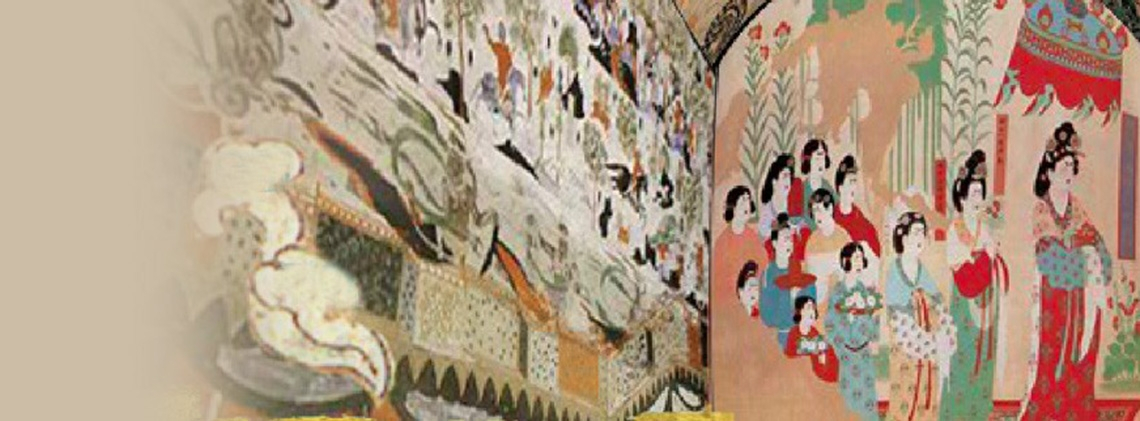
Chinese Mural Art
Splendid
Chi Culture
Topic
Chinese Mural Art
Nature is an extraordinary artist—it carves numerous caves and grottoes that are both astounding and serene. These places reveal not only a mysterious, subterranean world, but they also provided primitive homes for early humans. Since hominids were discovered to have lived caves at Zhoukoudian and Shandingdong (Upper Cave) near Beijing, Chinese archaeologists have found an increasing number of natural caves used as living spaces by early man. It can be surmised that cave living was typical of the time and satisfied the needs of the inhabitants. Under such circumstances, a new type of art form, mural painting, was created. Early humans carved and painted various designs in caves or on cliffs to record events or express themselves. Carvings were the earliest forms of murals. One of the earliest painted murals was discovered in a cave in Chauvet, France. Early murals are named after their locations, thus the murals at Chauvet are also known as cave paintings. In Xinjiang and northern China, there are a large number of cliff paintings.
Basic types of mural paintings include those done on cliffs, grottoes, as well as murals in monasteries and temples, and tomb chambers. There were two methods of mural painting, drawing and crafting. The first method involved the painter directly drawing on the wall, a technique that was commonly used in ancient China. Craftwork involved attaining the final result by means of various techniques of artistic reworking, thus allowing the painter to give full play to his artistic craft and bring out special textural and tactile effects. No other painting tools could achieve such special artistic effects.
The transformation of religious thought in China can be traced through murals. The mural paintings of early society were closely related to spirit medium arts and totemic activities. As the economy developed, murals were used to decorate palaces, as well as some sacrificial sites. Some rulers treated mural paintings as a form of entertainment and a means to propagate a ritual system. When Buddhism entered China around the Qin-Han era (221 BCE–220 CE), the content of murals also changed: from depictions of heaven and earth, mountains and rivers, spirits, and ancient sages in earlier days to Buddhist stories. During the Qin and Han periods, palaces and court offices were all decorated with murals.
Unfortunately, as these old buildings were demolished or disappeared, the murals in them nearly vanished forever. It was not until the 1970s, when the site of the Xianyang Palace of the Qin was discovered, that traces of the brilliant mural paintings of the Qin palace were revealed for the first time. When Buddhism reached its peak during the Sui (581–618) and Tang dynasties (618–907), there were more than 150 Buddhist monasteries and Daoist temples in the Tang capital of Chang’an. Accomplished painters and sculptors came to the capital from all over to create works for monasteries, temples, grottoes, and tombs. Their creations show the integration of northern and southern Buddhism. Yan Liben (ca. 600–673), Dong Boren (fl. mid–late sixth century), Wu Daozi (fl. 710–760), Wang Wei (699–759), and Zhang Sengyou (fl. 500–550) were all famous mural painters at that time. Meanwhile, new painting styles and subjects were introduced to the Central Plain from the Western Regions. Beginning in the Yuan dynasty (1271–1368), Buddhism and Daoism grew to be equally popular and Buddhist monasteries and Daoist temples were constructed everywhere. They were not only religious sites, but were also places where market fairs and cultural exchanges took place. Such places promoted the melding of murals and folk arts. During the Ming dynasty (1368–1644), murals could not match the grandeur of those created during the Tang and Song (960–1279) eras, but the Ming rulers continued to use religious art to promulgate their vision of social order. The construction of monasteries and temples, the printing of Buddhist and Daoist canons was happening everywhere. During the Qing dynasty (1644–1911), traditional Chinese mural painting, which had continued for thousands of years, began to decline. The numbers of independent mural painters and the quality of the art reached an unprecedented low. Among all the murals in monasteries, temples, and palaces, the most noteworthy were those depicting major current events, folktales, and scenes from famous literary works. For example, in the assembly hall east of the Ancestral Hall of the Potala Palace, a mural depicts the fifth Dalai Lama, Lobsang Gyatso (1642–1682), who came to Beijing with a delegation of three thousand, meeting with the Shunzhi emperor (r. 1643–1661). The mural, just like a picture-story book, successfully includes a large number of historical figures and a wealth of activities. It is a masterpiece of Qing mural painting. After the Xinhai Revolution (1911), large-scale murals were basically discontinued as they had lost the spaces they once depended on.
After the People’s Republic of China was founded, and with the emergence of socialist reconstruction, mural paintings began to gain attention, and their vitality was once again renewed. In addition to historical figures, tales, myths, and legends, new themes were introduced, including ethnic customs, China’s majestic landscape, human civilization, science and technology. Throughout the history of human development, cultural prosperity and mural paintings have been closely related.



